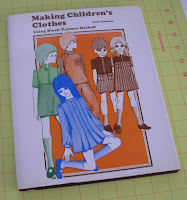As I was designing Prairie Roses for Fall 2007, I created a digital design board. In school it was all about literally cutting and pasting paper onto illustration board. I like the digital version because it is much faster and more professional looking.

I had a hard time identifying and explaining the look I wanted. When I started it was simply a feeling. I decided a story board was the best way for me to explain my line to myself. I have rarely done this in the past - it always seemed like busy work. This time, I have convinced myself of it's necessity. As I struggled to find pictures that explained the mood, everything else seemed to fall into place. The words
A Country Sensibility came to me and it was perfect for so many reasons. It made me think of
Sense and Sensibility and Jane Austen - how can I translate Jane Austen's "look" into little girl's dresses. It made me think about sensible country living. Being grateful for what you have. Not living too extravagantly - but comfortably.
Anyway, I headed out with my camera and took pictures of the flowers growing in my flower beds and nearby scenery. There was my mood. I already had purchased the fabrics and they meshed perfectly. The red ombre ribbon roses were the highlight and the key to the brand name.
Prairie Roses was a difficult brand name to nail down. Do you know how hard it is to find a brand name that is not already in use? One that fits the mood and explains the look without the customer ever seeing the clothing? This is complicated by trying to find an internet domain name that is available. It took weeks of research.
The work required to pull all of this together had other benefits. I emailed a graphic designer a copy of my design board and she was able to design my logo (which is shown on the right). I am fairly pleased with the results of the line, the logo, the brand. It all meshed together so perfectly. It feels good to be focused and I am excited about designing more for this line.
Next week is even better. I have been working on toddler patterns and I have a fitting/photo shoot scheduled. I am excited!




